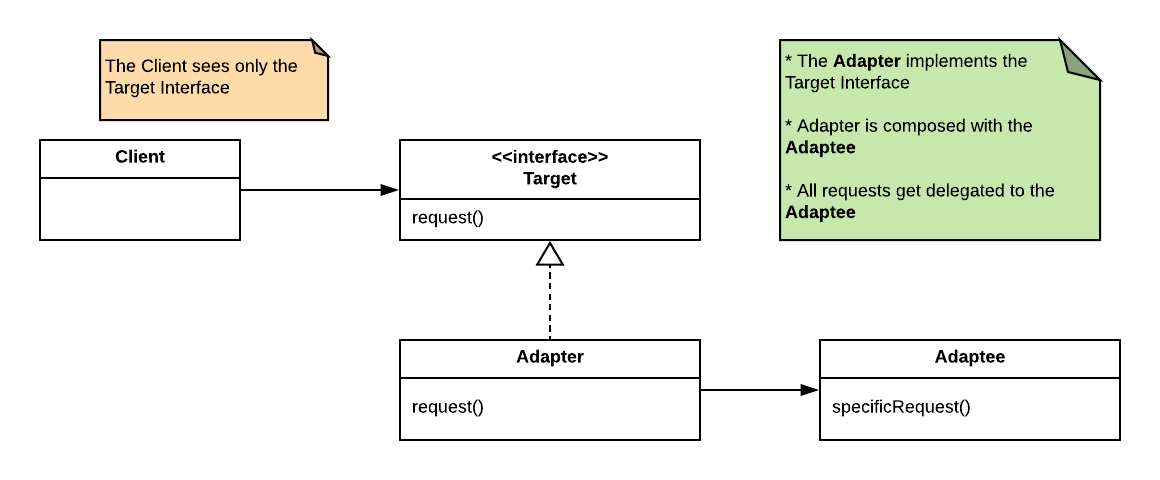Design Patterns - Adapter Pattern
15 Jul 2018
Convert the interface of a class into another interface that the client expect. Adapter lets class work together that could not otherwise because of incompatibility interfaces. ~ Gang of Four
| Intent | Match an existing object beyond your control to particular interface |
| Problem | Unable to use certain classes because of their interface mismatch |
| Solution | The Adapter provides a wrapper with the desired interface |
| Participants and Collaborators | The Adapter adapts the interface of an Adaptee to match that one of the Adapter’s Target, which allows the Client to use the Adaptee as it were a type of Target |
| Consequences | The Adapter pattern allows for preexisting objects to fit into new class structure without being limited by their interface |
| Implementation | Contain the existing class in another class. Have the containing class match the required interface and call the methods of the contained class |

Summary
- When you need to use an existing class and it’s interface is not the one you need, use Adapter
- It is implemented by creating a new class with the desired interface and then wrap the original class methods to effectively contain the adapted object.
- An adapter wraps an object to change its interface, a decorator wraps an object to add new behavior and responsibilities and facade wraps a set of objects to simply.
This file contains hidden or bidirectional Unicode text that may be interpreted or compiled differently than what appears below. To review, open the file in an editor that reveals hidden Unicode characters.
Learn more about bidirectional Unicode characters
| package com.art.head_first.turkeyadapter; | |
| public interface Duck { | |
| public void quack(); | |
| public void fly(); | |
| } |
This file contains hidden or bidirectional Unicode text that may be interpreted or compiled differently than what appears below. To review, open the file in an editor that reveals hidden Unicode characters.
Learn more about bidirectional Unicode characters
| package com.art.head_first.turkeyadapter; | |
| import org.junit.Test; | |
| public class DuckTestDrive { | |
| @Test | |
| public void testTurkeyAdapter(){ | |
| MallardDuck duck = new MallardDuck(); | |
| WildTurkey turkey = new WildTurkey(); | |
| System.out.println("**************************************************"); | |
| System.out.println("Turkey Says: "); | |
| turkey.gobble(); | |
| turkey.fly(); | |
| System.out.println("**************************************************"); | |
| System.out.println("Duck Says"); | |
| performDuckActions(duck); | |
| System.out.println("**************************************************"); | |
| System.out.println("Turkey Adapter Says: "); | |
| Duck turkeyAdapter = new TurkeyAdapter(turkey); | |
| performDuckActions(turkeyAdapter); | |
| } | |
| private void performDuckActions(Duck duck){ | |
| duck.quack(); | |
| duck.fly(); | |
| } | |
| } |
This file contains hidden or bidirectional Unicode text that may be interpreted or compiled differently than what appears below. To review, open the file in an editor that reveals hidden Unicode characters.
Learn more about bidirectional Unicode characters
| package com.art.head_first.turkeyadapter; | |
| public class MallardDuck implements Duck{ | |
| @Override | |
| public void quack() { | |
| System.out.println("Quack"); | |
| } | |
| @Override | |
| public void fly() { | |
| System.out.println("I'm Flying"); | |
| } | |
| } |
This file contains hidden or bidirectional Unicode text that may be interpreted or compiled differently than what appears below. To review, open the file in an editor that reveals hidden Unicode characters.
Learn more about bidirectional Unicode characters
| package com.art.head_first.turkeyadapter; | |
| public interface Turkey { | |
| public void gobble(); | |
| public void fly(); | |
| } |
This file contains hidden or bidirectional Unicode text that may be interpreted or compiled differently than what appears below. To review, open the file in an editor that reveals hidden Unicode characters.
Learn more about bidirectional Unicode characters
| package com.art.head_first.turkeyadapter; | |
| public class TurkeyAdapter implements Duck { | |
| Turkey turkey; | |
| public TurkeyAdapter(Turkey turkey) { | |
| this.turkey = turkey; | |
| } | |
| @Override | |
| public void quack() { | |
| turkey.gobble(); | |
| } | |
| @Override | |
| public void fly() { | |
| for (int i=0; i<5; i++){ | |
| turkey.fly(); | |
| } | |
| } | |
| } |
This file contains hidden or bidirectional Unicode text that may be interpreted or compiled differently than what appears below. To review, open the file in an editor that reveals hidden Unicode characters.
Learn more about bidirectional Unicode characters
| package com.art.head_first.turkeyadapter; | |
| public class WildTurkey implements Turkey{ | |
| @Override | |
| public void gobble() { | |
| System.out.println("Gobble Gobble"); | |
| } | |
| @Override | |
| public void fly() { | |
| System.out.println("I'm flying short distance"); | |
| } | |
| } |